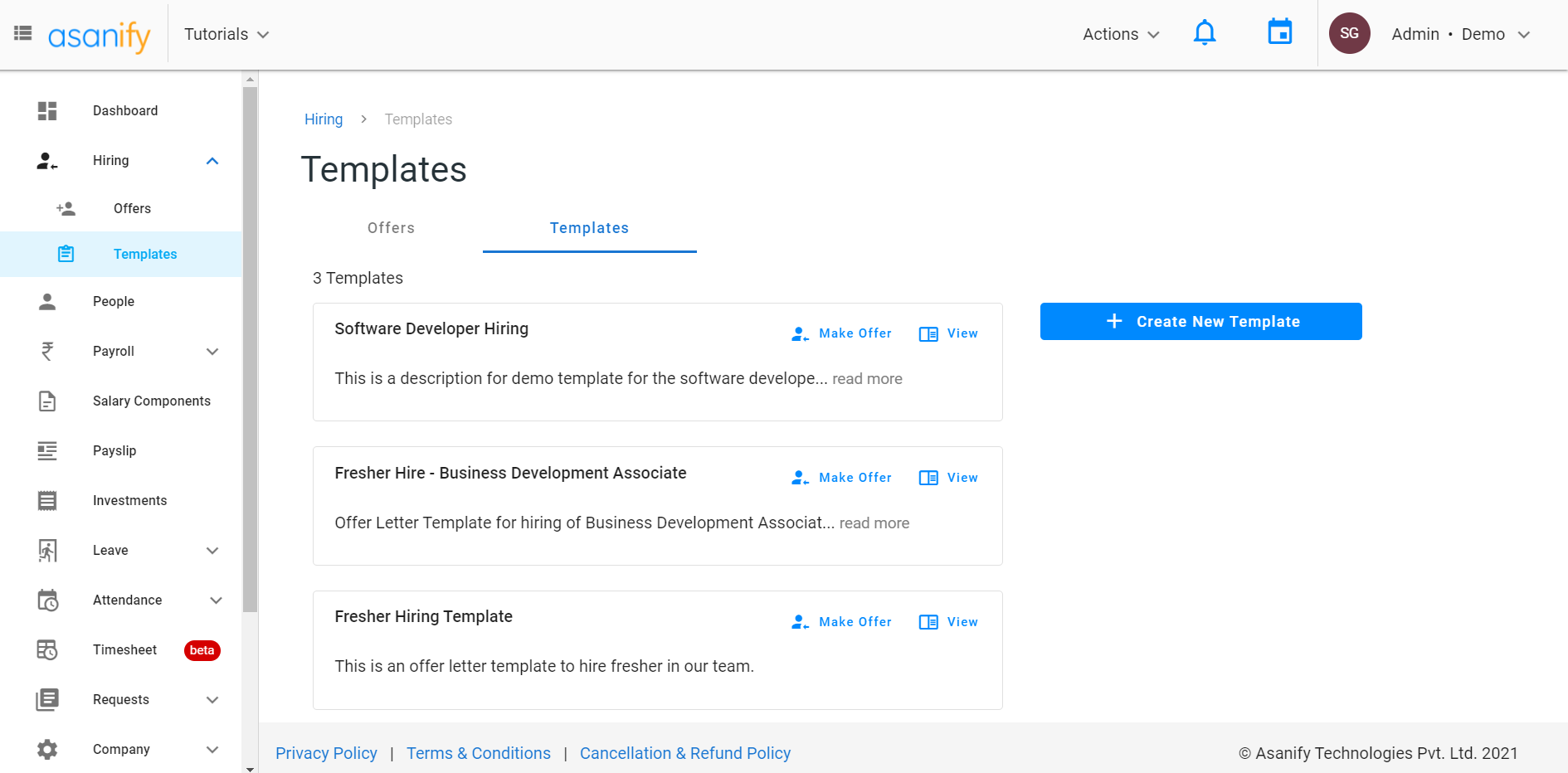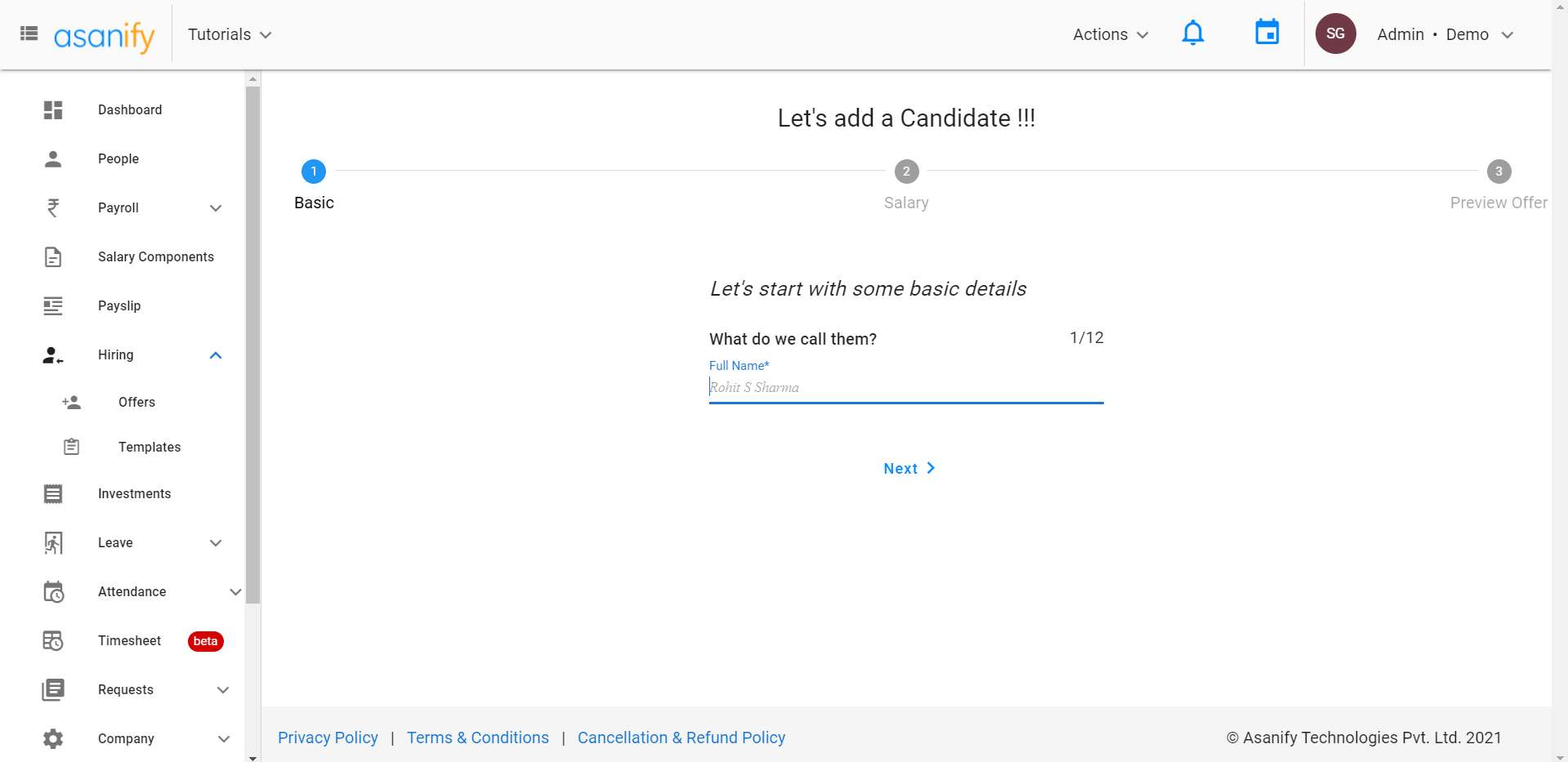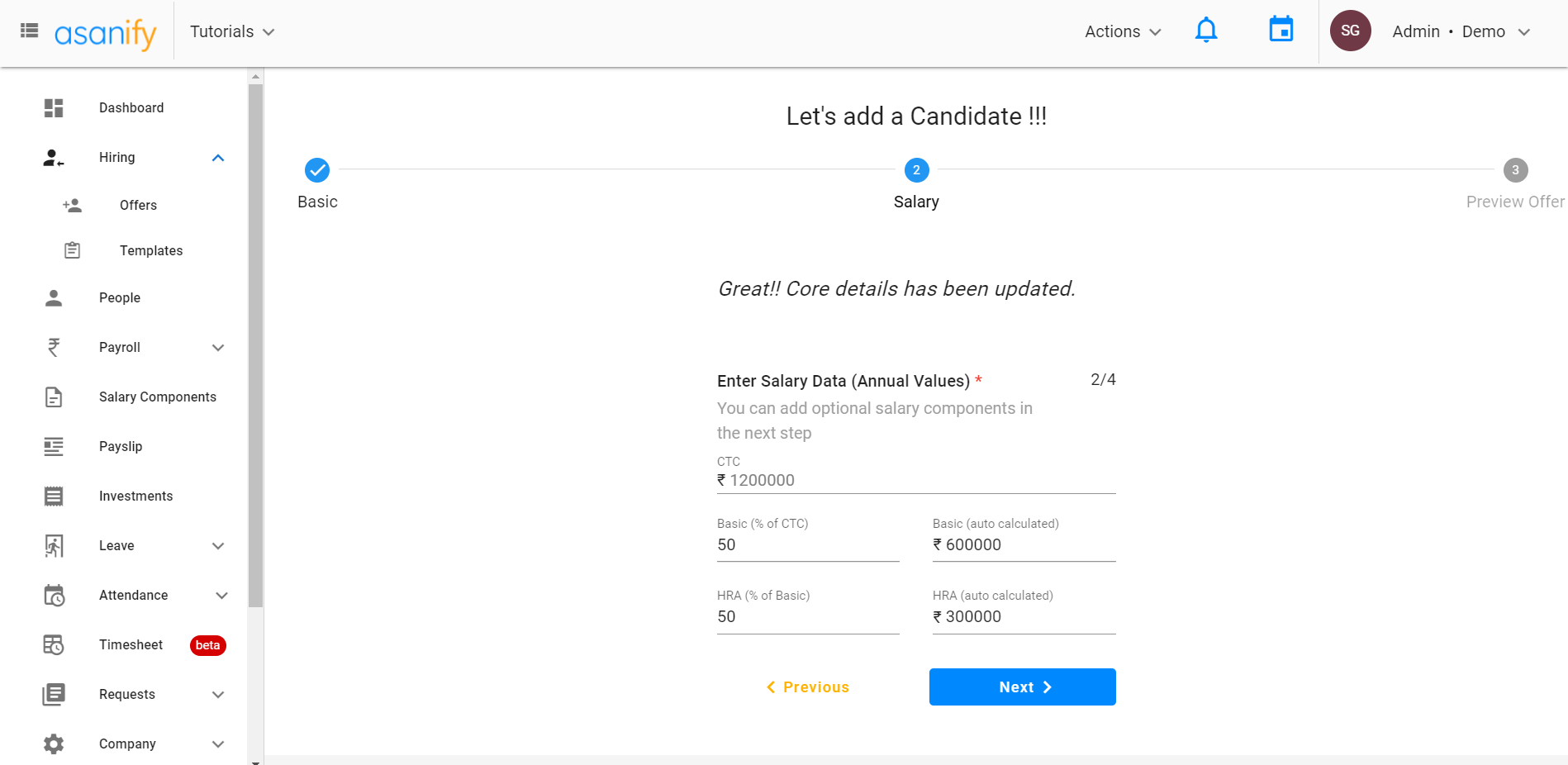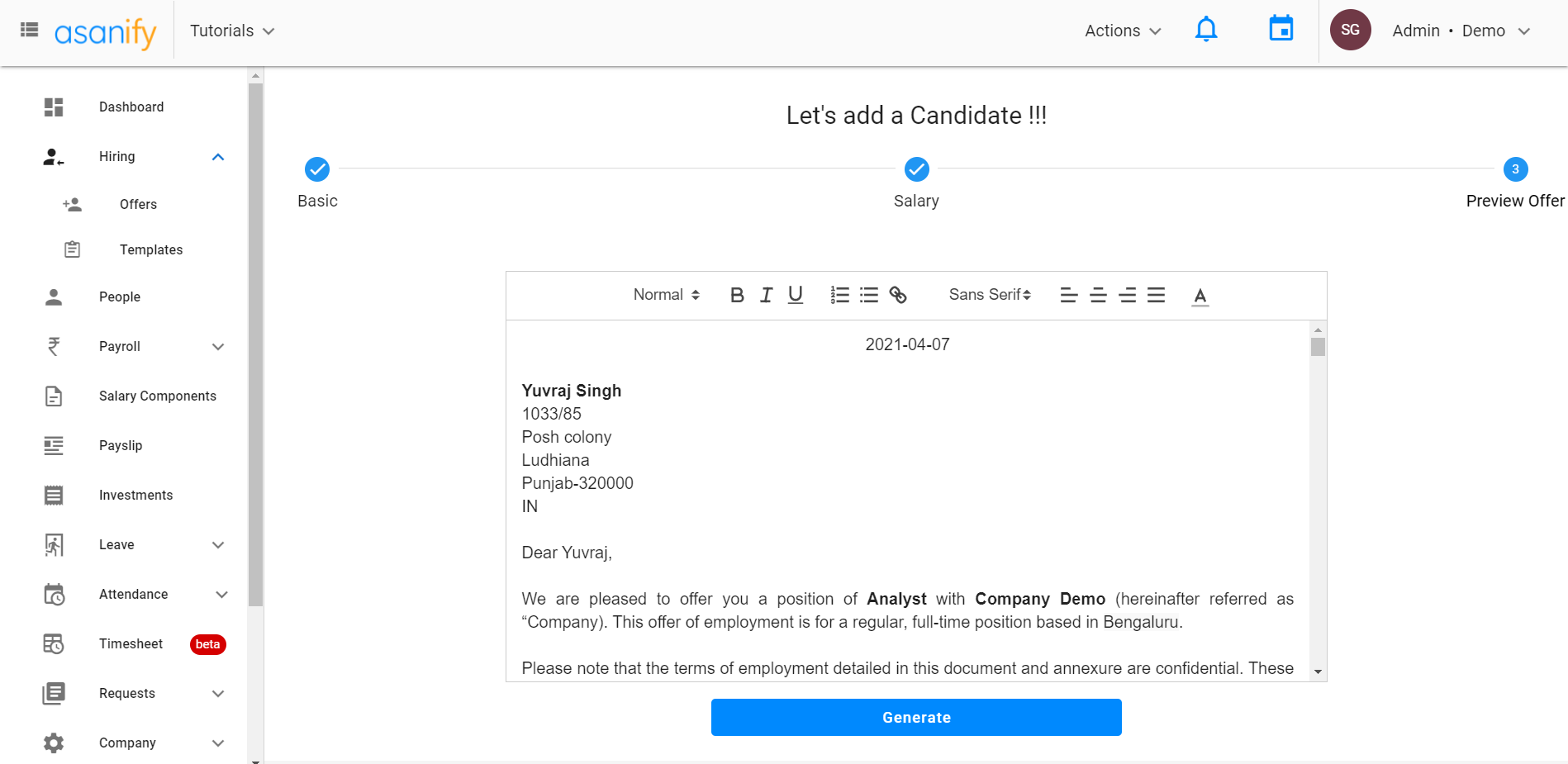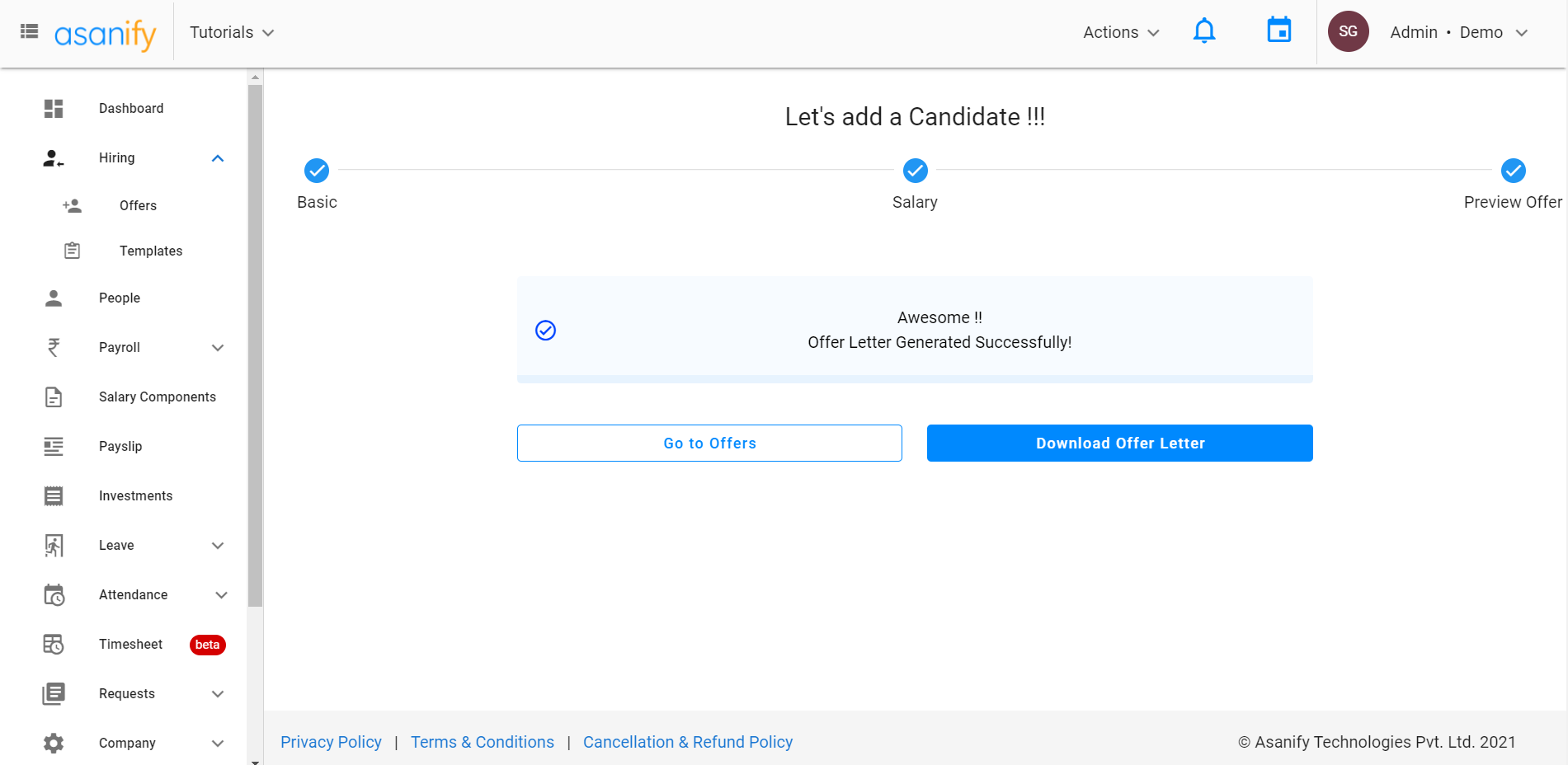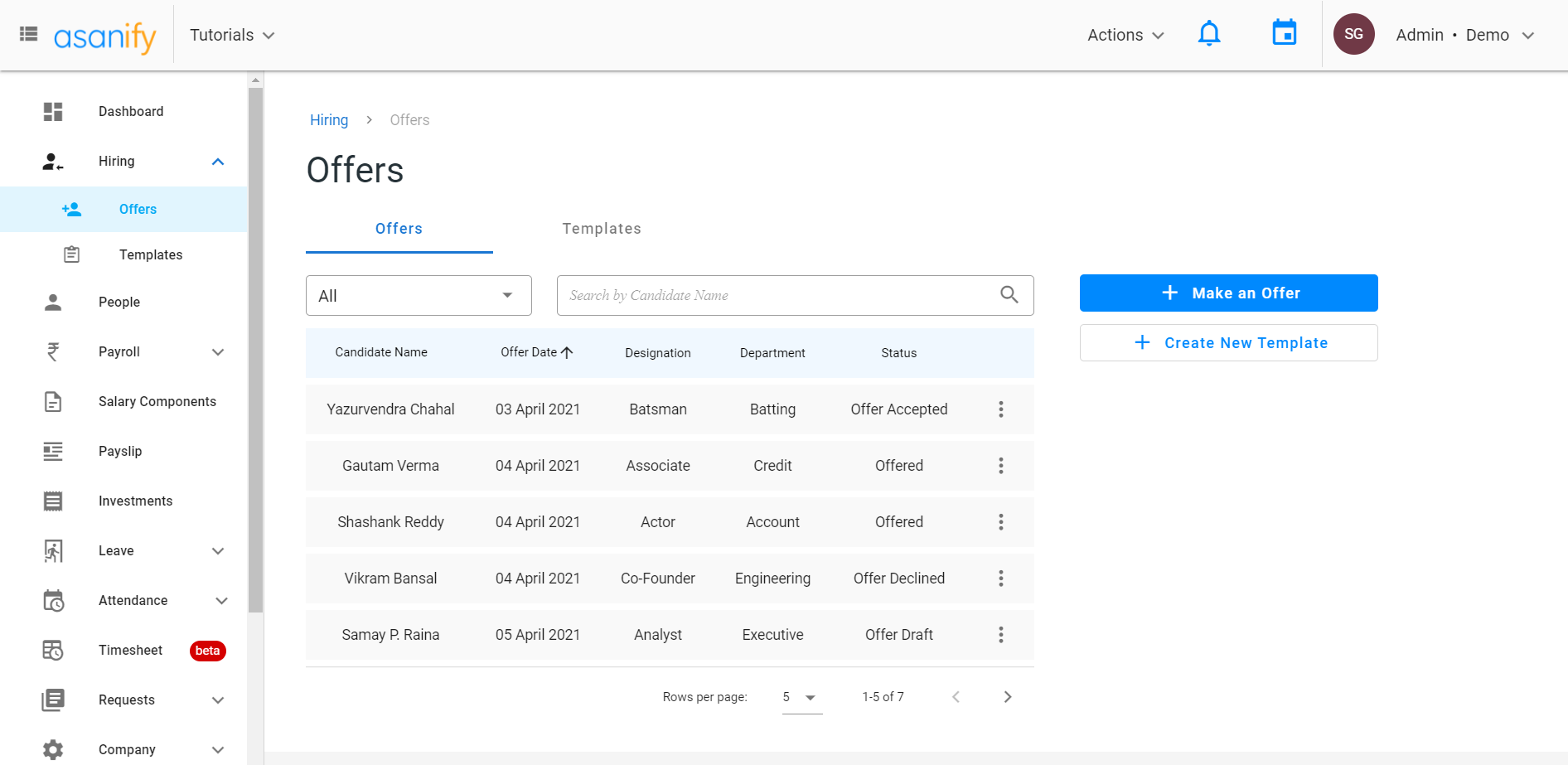How do you make a perfect job offer letter to ensure the candidate will accept the offer? You’ve spent a lot of time trying to find the right candidate for a job opening. But what next?
I have written a comprehensive guide on how to create a good job offer, the things to include in the job offer and a lot more. I have covered the following…
- What is a job offer letter?
- Why is sending a written offer letter important?
- What are the components of an offer letter template?
- Types of offer letters?
- What is the ideal offer letter generation process?
- Tips and tricks to improve the job offer letter you send out
- What should be done after the candidate accepts the offer?
- How do you react if a candidate has rejected the offer instead?
- What is a job offer acceptance rate?
- How do you improve your company’s job offer acceptance rate?
- Summary
- FAQs
Download the job offer letter template by filling out this quick form!
What is a job offer letter?
An offer letter is a formal HR letter that is sent to the candidate after he or she is selected for a job. It serves as an agreement between the employer and employee and generally provides the key terms of joining for the selected candidate. An offer letter is basically a written confirmation of all the details of the job such as job description, salary and compensation details etc. The candidate signs it as a sign of acceptance of the job offer.
Under normal circumstances, you could send it to the candidate via mail or handed over face-to-face. However, given the current conditions with covid-19, you could send it via e-mail, ask the candidate to print it out, sign it and send a scanned copy back to you via email.
Why is sending a written job offer letter important?
Any candidate applying for a job with your company will, in all probability, be applying to other companies as well. In such cases, how do you ensure that the candidate chooses your company over the others? The offer letter you write might just tip the scales for you! And no, I’m not talking about the salary figure you put in the letter. This includes the way it is structured, the language and the details included as well. The way you write the letter reflects your company’s culture and attitude.
A job offer letter allows you to summarize everything that the job entails
During the entire selection process, you have discussed details about the job with the candidates. Details about the joining date, job description, daily tasks of the job, company policies etc. But all these discussions were verbal. There is no written document offering proof of these details. The offer letter serves as a written document and proof for both the candidate as well as the employer.
A job offer letter serves as a reference point for future negotiations
If the candidate wants to renegotiate things like salary, leaves etc., a written offer letter acts as a good reference point for them and you. On the other hand, if an employee wants to negotiate any of these factors later after they have started working with the company, they will be able to should the offer later as a baseline for that discussion.
What are the components of a job offer letter – job offer letter format
 Offer letter templates can vary from one employer to another. But there are a set of elements that should be included in the template no matter what. This will help you avoid any kind of confusion or misunderstanding later on once the employee has been onboarded. While writing the letter, you should give specific details for each of these points.
Offer letter templates can vary from one employer to another. But there are a set of elements that should be included in the template no matter what. This will help you avoid any kind of confusion or misunderstanding later on once the employee has been onboarded. While writing the letter, you should give specific details for each of these points.
Ideally, you should make a verbal offer on-call or face-to-face before sending the written offer. This helps personalize the offer letter generation process and ensures that the candidate has a better experience.
Introduction (an important part of a job offer letter)
At the beginning of the offer letter, congratulate the candidate for having been selected for the job. Mention their name here as well. This adds a personal touch to the offer and warms the candidate a little towards the company.
The job title is an important component of a job offer letter
I think this is one of the most obvious elements you should add. The candidate should be aware of the title of the role they are going to fill.
Job description (a brief version can be included in the offer letter)
You should add a crisp and informative paragraph or bullet points in the letter talking about the job description. Specific details about the day to day tasks, responsibilities, whether the role is part-time or full time etc. make for a good job description in the job offer. Here, you may also add information about who the candidate will report to (their manager, supervisor etc.) once they become an employee.
A job offer letter must contain the employee’s joining date
This is also known as the date of joining. The letter should clearly indicate a date when you as an employer expect the candidate to start work. This is so that the candidate is well aware of when they need to be available. You could also add a line saying that if the joining date isn’t suitable for the candidate, they can get in touch with you immediately. However, this last statement is applicable only if you have the luxury of time and can wait if the candidate decides they want the push the joining date by a week or so (completely optional).
Deadline to accept the job offer
Very often the candidate does not accept the offer on the spot. This can happen if they are deciding between multiple job prospects. In such cases, you probably won’t be able to wait forever for the candidate to make up their mind. Hence, put an expiry date on the offer. This will compel the candidate to make a quick decision. Besides, creating a certain urgency for the job is always a good thing because it makes the candidates act in the ‘now’ and will also save your time.
Mention work schedule and structure in the job offer letter
Do your employees work on Saturdays? Do you expect employees to begin working at 8 am or go on working until 6 pm or 10 pm every night? or do you offer more flexibility in working hours? All this information needs to be passed on to the selected candidate as a part of the offer letter.
This section may also include details about a probation period if it applies to your business and the role you are filling up.
Salary structure is an extremely important part of a job offer letter
This is probably the most important component. The salary structure or the compensation package is usually discussed verbally but also is very important to mention it in writing. Details about the salary, which is what the employee will be making on an annual or monthly basis must be explicitly mentioned here. In this part of the salary structure, you must mention all the fixed and variable (if applicable to your company) aspects of the salary.
Company policies should also feature in the job offer letter
You could mention in short what policies are applicable to the new employee here. Be it leave policy, maternity policy (if applicable to your company) or even your work from home policy, any new employee joining your company should know about these policies.
Employee benefits in the job offer letter
Employee benefits and perks cover a wide range of topics like
- Insurance
- Time off
- Additional compensations or bonuses
- Medical reimbursements
- Retirement plans
It might not be possible for you to mention all of this in detail in the offer letter, but, in short, you should mention the ones that are applicable to your startup and to the potential employee you want to onboard.
List the documents that need to be submitted in the job offer letter
Mention a list of documents that the candidate is expected to send to you at the time of accepting the offer. This list should include a photo ID, address proof, the relieving letter from the previous employer, academic or experience certificates etc.
Privacy policy or NDA as a part of the job offer letter
Usually, all companies send an NDA i.e. a non disclosure agreement. Sending an NDA as a part of the offer letter can protect your intellectual properties. A privacy policy is legally binding, hence, carefully state the repercussions of not abiding by the policies as well.
Conclude the job offer letter with the terms and conditions under which employment is being provided
This is mentioned at the end and states all the details about how and under what conditions employment can be terminated. This section should ideally be consistent for all your employees. Talk about the ethical or professional issues that could lead to you having to terminate the employee.
Here you could also talk about termination and the notice period. There is usually a specific amount of time before which you can ask an employee to leave on the same day itself. In some cases, the employee can also leave without any prior intimation. However, otherwise, notice periods are usually 30-90 days. This means that if you fire this employee or they wish to leave, the employment will only actually end after the notice period is over.
Signatures of both employer and employee on the job offer letter
Once you as an employer have signed the offer letter, the potential employee too must sign it. When the offer letter is signed by your employee, it means they have accepted the offer and agree to the terms and conditions discussed and mentioned in the letter.
Download the job offer letter template for free from Asanify by clicking here!
Types of job offer letter templates?
There are different offer letter types or templates that you can send out. I have listed some of them below. You can pick and choose the one that is most suited to your company or the role for which you are sending an offer letter.
General job offer letter
As the name suggests, this is generic. It can be used for any candidate, regardless of what their role in the company will be. Either the HR or in case you as a founder manage all the HR responsibilities then you have to fill in candidate-specific details depending upon whom they are sending the offer to. However, the same template or overall structure can be used across the company.
Formal job offer letter
This is one that includes all the details relevant to the job. You should use formal language and even send an email with which the letter is attached. This offer letter should be all-inclusive and must have details about everything including the terms and conditions of employment. It is usually sent when a candidate is applying for a full-time position.
Informal job offer letter
An informal offer letter could be sent to candidates selected for part-time roles within your company. Such informal letters do not carry as many details as the formal ones and are sent by companies that are not as stringent with rules and regulations. Even though they carry less information and are not as comprehensive, they are just as official.
Part-time to full-time offer letter
Very often companies hire employees on a part-time or contractual basis first as a trial. This is their way of testing the waters. If you hire employees the same way then you need to keep in mind that when you transition your employees to full-time, you need to send them another offer letter.
This type of letter is also known as a transitionary offer. Such a letter should explicitly highlight all the changes that are brought about as a result of the shift from part-time to full-time. This means details about the change salary package, employee benefits, day-to-day tasks, who the employee reports to, work structure etc. should be included.
Internal job offer letter
This type of offer letter is very similar to the previous type. The kind of content to be included is also the same. Here, it is given to employees who receive a promotion or in case of a change of department. However, before sending a written letter, it is mandatory for you to have a conversation with your employee to ensure that this change in role is in line with the employee’s individual career goals.
Download the job offer letter template for free from Asanify by clicking here!
What is the ideal job offer letter generation process?
The offer letter generation process is not simple if done manually. But if you use a top offer letter software to generate the letter, you could reduce your workload drastically. Asanify offers a free offer letter generator if you want to try Asanify’s recommended template. In addition, once you sign up for the full Asanify HR Software you may create as many templates as you want.
To create an offer letter using Asanify Hr Software,
- Go to the ‘Templates’ page
Offer letter generation is one of the many features Asanify has to offer. To get started, go to ‘template’ in the ‘hiring’ section.

- Select a template
We have default templates that you could use. Or, if you have an offer letter template you wish to use along with the HTML code, you can go ahead and import it to the software.

- Click on make an offer button and then add candidate’s details
Start with adding details about the candidate, like their name, designation and other demographics like home address, age etc. which will get added to the template.

- Add salary details
When you add salary details you will also have to add the break up of the basic salary, house rent allowance, special allowance, bonus etc. according to what is applicable to your company. You could visit our blog to get a deeper understanding of what are the components of a payslip.

- Validate or preview offer letter
After adding all the details about the candidate and salary-related information, validate and check the offer letter.

- You can generate a pdf of the offer letter and download it
Finally, you can download a pdf of the offer letter to send it to the candidate you wish to offer a job!

- Track multiple offers made at the same time without any hassle
If you are hiring many candidates and have sent out offer letters to all of them, it might be difficult to keep track of the status of each one. You can easily track their individual status with our software

Download the job offer letter template for free from Asanify by clicking here!
Tips and tricks to improve the job offer letter you send out
There are a lot of other details that you need to take care of while sending out this letter.
You may also try out our free offer letter software
Apart from simply drafting the letter, you should,
- Personalize the letter
- Make sure that you verbally agree to all the details before sending a final written offer letter.
- Don’t leave out any details. Make sure that the offer letter is all-inclusive with no space for loopholes or confusion
- Ensure the employee that once they have accepted the offer, they will receive a welcome kit and will go through a proper onboarding process.
- Maintain transparency throughout, not just during the selection process, but even now as you make an offer and look forward to onboarding the candidate.
- Use HR software to speed up the entire process
- To avoid any legal issues, ensure that you haven’t used any language that implies any kind of contractual obligations that weren’t intended. Preferably sit down with your lawyer before sending out the offer letter.
- Given the covid-19 situation, send the letter via email. Frame the email well, and mention the candidate’s name. Add a statement about how you are happy to have them join your company in the email.
- Double-check the letter for any kind of typing errors before sending it.
Download the job offer letter template for free from Asanify by clicking here!
What should be done after the candidate accepts the job offer?
You have gone through a long selection process, selected the best candidate and used a good offer letter template. Now, if the candidate chooses to, they should accept the job by writing a job acceptance letter, stating that they accept the terms and conditions mentioned in the letter sent to them. But what do you do next?
How do you ensure that the candidate feels welcome and has the smoothest onboarding experience?
Send a welcome kit
After the candidate has sent you a signed job acceptance letter, you should send the candidate a good welcome kit from your company. This will help them feel like they are a part of your organization even before they have their first day. A welcome kit usually includes-
- A personalized welcome letter from the founder of your startup (i.e. from you!)
- An employee handbook which includes a copy of the company’s vision, mission statement and goals
- A swag bag
- A checklist of things to be done in the first month of joining
- You could also include a pack of masks with your company logo or sanitisers on them as a part of your welcome kit
Onboard the new employee
Very often people misunderstand the onboarding process for an orientation. Orientation is a session that is a part of the onboarding process. Whereas the onboarding process can last for as long as 6 months as well.
An onboarding session should include a formal introduction with the entire team, set clear goals at least for the first month, mention who the supervisor is etc. You should also give your new employee basic instructions about parking (post covid), dress code (if any) and so on. Plan and schedule regular follow up sessions with the new employee to make sure they are adjusting well in the organization. You could also eventually ask them for feedback regarding your company and areas of improvement.
How do you react if a candidate rejects the offer instead?
Just like you had many many candidates to choose from, the candidate you select might also have many companies or employers to choose from. Therefore, there is always a chance that the candidate might reject your offer. This rejection might take place because maybe the salary you offered wasn’t good enough for them, their personal values or goals didn’t match that of the company or maybe they have a better offer in hand. In such a situation,
Be polite and don’t keep emailing the candidate
Accept the fact that your best applicant rejected your offer. Know when to stop following up on the offer and move on. What I mean is, if a candidate has rejected the offer, you could send a single follow up email asking them if they have changed their mind. Beyond that don’t follow up anymore. Don’t take it personally and know how to take no for an answer.
You may also send a formal note appreciating the fact that they took part in the selection process. This helps provide a positive candidate experience. A little appreciation goes a long way. Especially with websites like Glassdoor that offer applicants a chance to publicly review employers and give feedback.
Ask for reasons for rejecting the offer
If you have many candidates reject your job offers, you should probably ask them why. There might be something wrong with the way you approach the candidates or carry out your hiring process.
By asking them for a reason, you will also know if they have rejected it based on the salary package, employee benefits or anything that might be negotiable. In which case, you should revisit the offer and try making some changes if possible.
Try to better your employer brand
This is another space you should look at if a candidate rejects your job offer. Social media can work as a blessing or a curse in this case. While you can showcase how amazing a workspace you have it is also a place where unhappy employees can voice their points of view. Your current employees are the absolute best advocates you could ask for to improve your employer reputation. Make sure they are happy! At the end of the day, your employees should think of your company as the best place to work.
Download the job offer letter template for free from Asanify by clicking here!
What is a job offer acceptance rate?

This metric is usually calculated annually, but may also sometimes be done on a monthly basis, especially if many candidates were recruited during a particular month. While calculating the offer acceptance rate, you shouldn’t take into account the offers that were made verbally during the selection process. Only consider the ones made at the end once the candidates are selected. The higher the offer acceptance rate, the better your recruitment strategy.
How do you improve your company’s offer acceptance rate?
If you calculate this metric for each hiring manager or department, you will be able to put your finger on the exact problem area. Hence, you will be able to come up with a more specific solution quickly.
Faster selection process and better communication
Very often if you take your time in putting out the results of your selection process, you might not get positive responses. Either the candidates have already received better offers elsewhere or they have taken the slow process as a sign of no professionalism on your part.
Keep the candidates updated at every step of the way to make them feel wanted. This ensures an overall better candidate experience.
Strong offer letter
Your offer letter plays a huge role in the acceptance rate. Mistakes may portray a lack of professionalism or that you don’t care enough. Even gaps in details or contradictory statements in the letter may cause problems.
Summary
To summarize this blog, creating an offer letter is no small feat. But, with the right software, you can easily generate and personalize it for each candidate. It is imperative to make sure that you add all the elements while making one, so as to not leave any room for confusion.
So now, the next time you select a candidate you will be able to follow these steps, tips and tricks and write the most perfect offer letter that will compel the candidate to join your startup!
Download the job offer letter template for free from Asanify by clicking here!
FAQs
While writing an offer letter, you need to add details about the job, right from the title, description of day-to-day tasks, salary up to company policy and terms and conditions etc. Be sure to provide a space for the candidate to sign the offer letter to accept it.
Yes, an offer letter is a legal document. It is a contract signed both by the employer and employee and is valid and enforceable by an Indian court as per the Indian contract act
The validity of an offer letter depends on how the contract is made. The employer has the freedom to decide for how long the offer is valid. On average, employers usually provide a week-long validity.
Not to be considered as tax, legal, financial or HR advice. Regulations change over time so please consult a lawyer, accountant or Labour Law expert for specific guidance.


